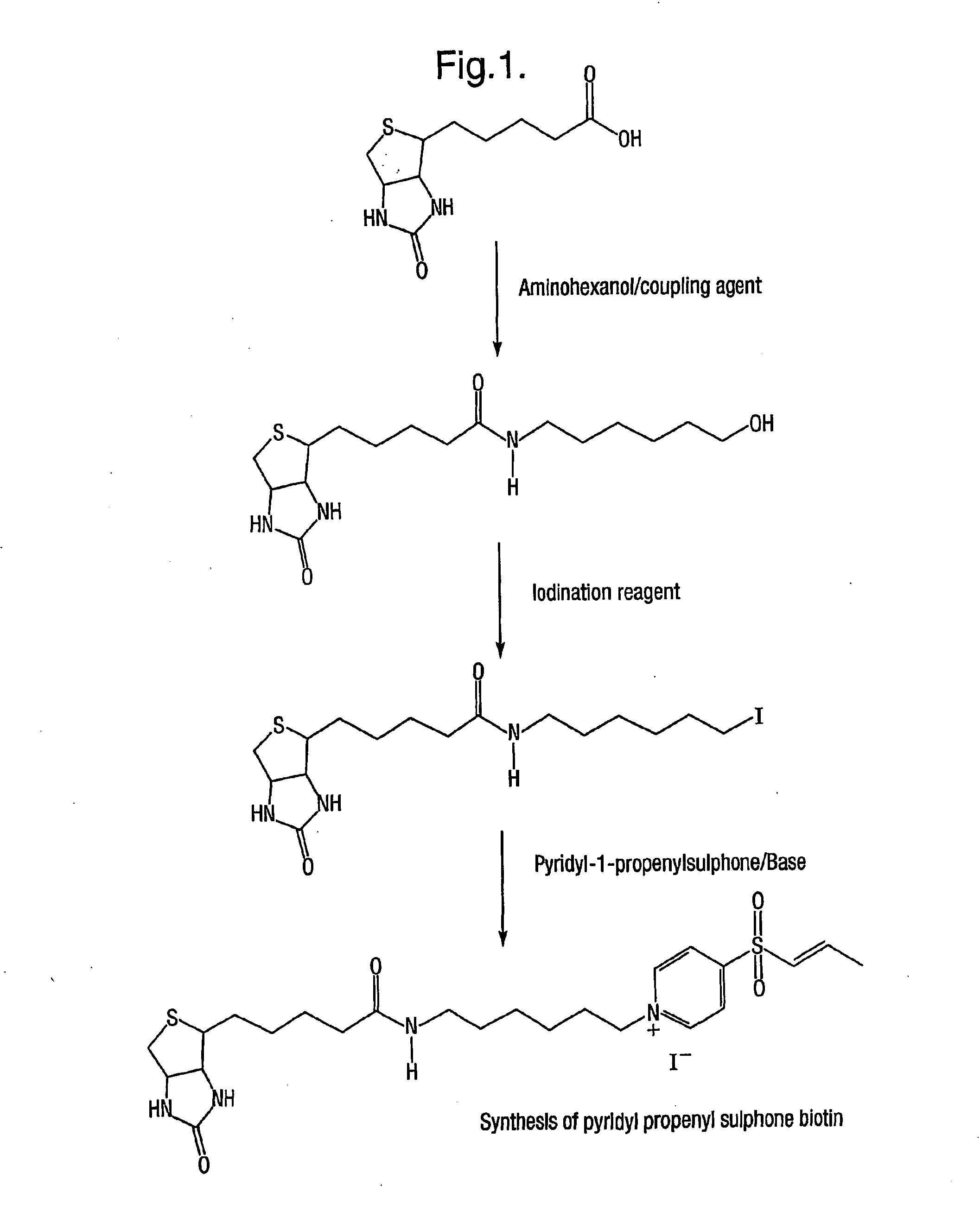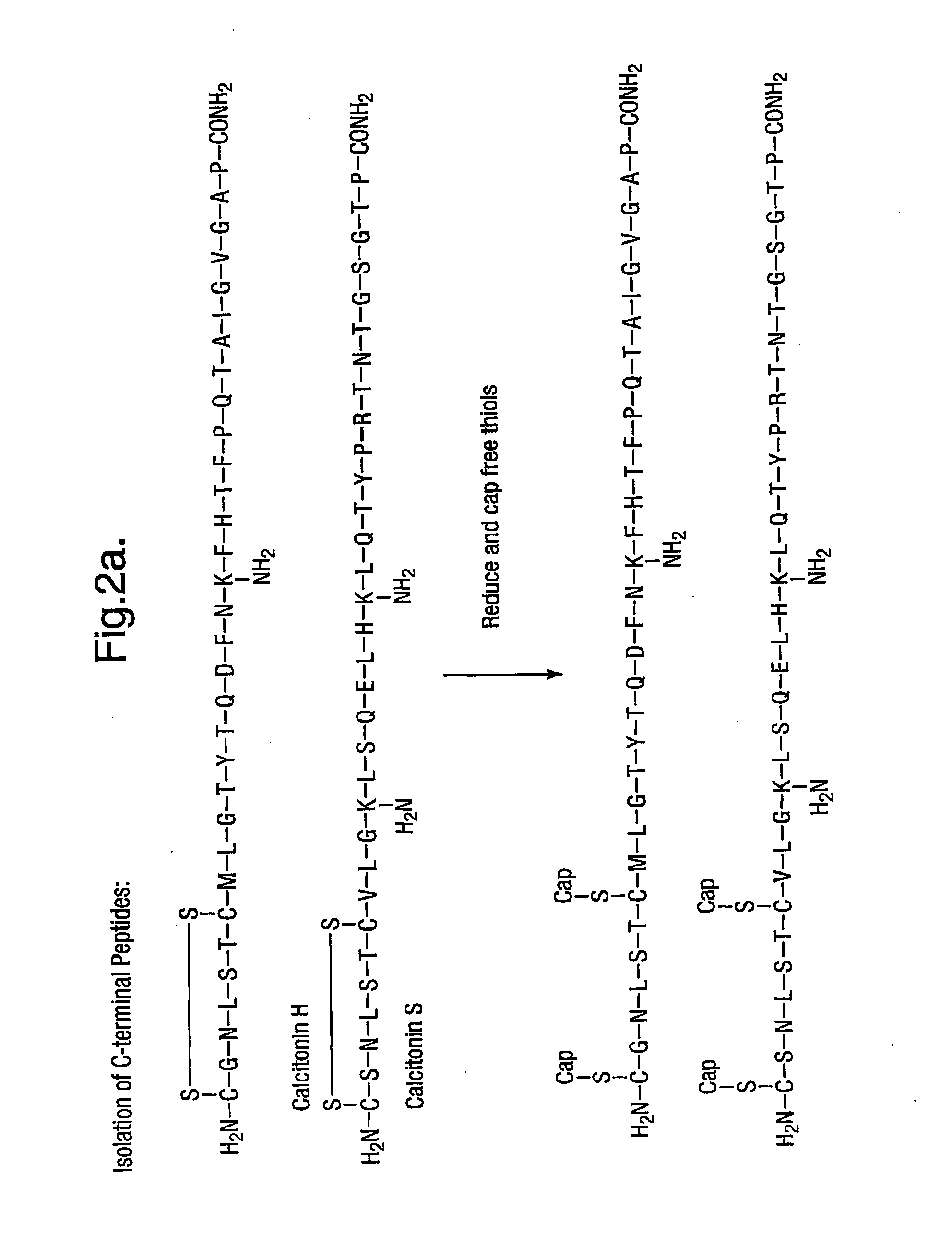Characterising polypeptides
- Summary
- Abstract
- Description
- Claims
- Application Information
AI Technical Summary
Benefits of technology
Problems solved by technology
Method used
Image
Examples
example 1
Isolation of C Terminal Peptides by Capture of Non-C-Terminal Peptides onto a Solid Support
An aspect of this invention provides a method of isolating C-terminal peptides from a mixture of proteins following protease digestion with either trypsin or Lys-C. After digestion the resulting mixture of peptides will contain α-amino and ε-amino groups all apart from the C-terminal peptide that will only have an α-amino group. Therefore, any compound that can preferentially react with ε-amino groups and be used to isolate these peptides away from the C-terminal peptide. Since the earlier examples in which peptides were labelled with ‘free’ maleimide showed that maleimide reacted reliably with epsilon amino groups and with some selectivity against alpha-amino groups and since polystyrene immobilised maleimide is commercially available (Fluka, Gillingham, Dorset, UK), its suitability as a reagent for C terminal peptide isolation has been investigated.
Reagents
4-(maleimidobutyramidomethyl)...
example 2
Synthesis of Pyridyl Propenyl Sulphone Biotin
Synthesis of Pyridyl-1-propenylsulphone
Preparation of Pyridine-3-sulphonylchloride: 3.18 g (0.02 mol) of pyridine-3-sulphonic acid (C5H5NSO3) was mixed with 8.34 g (0.04 mol) of PCl5 in a dry flask. The flask was protected from moisture and heated at 130-140° C. under reflux with stirring for 2 hours. The reaction mixture was then cooled. The cold solidified reaction mixture was then triturated with CHCl3 to remove PCl5 and POCl3. The supernatant liquid was discarded. The triturating process was repeated using fresh CHCl3 and the product was finally triturated with CHCl3 saturated with hydrogen chloride. The hydrogen chloride was prepared by the slow addition of concentrated sulphuric acid (H2SO4) from a dropping funnel to sodium chloride in a round bottom flask. The round bottom flask was connected to the trituration reaction vessel by rubber tubing. A white powder formed, which was filtered, washed with CHCl3 and finally dried in a ...
example 3
Isolation of a C-Terminal Peptide from a Single Polypeptides Using Enzymatic Cleavage and Pyridyl Propenyl Sulphonyl Biotin
In this Example, a small polypeptide, E. coli Thioredoxin (108 AA; available from Sigma-Aldrich, Dorset, UK) was subjected to the procedures of this invention in order to isolate its C-terminal peptide. This protein has 2 cysteine thiol groups, which are present as a disulphide bridge on the 3rd peptide fragment. Since this will not produce any cross-linked fragments, reduction and alkylation of the thiol groups was not performed, although capping of thiols would generally be preferable. The protein (17 mmol, available from Calbiochem Novabiochem, Nottingham, UK) was dissolved in 390 μl TEAA buffer 25 mM, EDTA 1 mM, Urea 0.3M, Thiourea 0.15M, 10% Acetonitrile, pH8. An aliquot of endoproteinase LysC (10 μg in 10 μL TEAA 25 mM, pH8, from Roche Diagnostic GmbH, Mannheim, Germany) was then added to the solution and the enzymatic reaction was left overnight. The no...
PUM
| Property | Measurement | Unit |
|---|---|---|
| Structure | aaaaa | aaaaa |
| Fraction | aaaaa | aaaaa |
| Water solubility | aaaaa | aaaaa |
Abstract
Description
Claims
Application Information
 Login to View More
Login to View More - R&D
- Intellectual Property
- Life Sciences
- Materials
- Tech Scout
- Unparalleled Data Quality
- Higher Quality Content
- 60% Fewer Hallucinations
Browse by: Latest US Patents, China's latest patents, Technical Efficacy Thesaurus, Application Domain, Technology Topic, Popular Technical Reports.
© 2025 PatSnap. All rights reserved.Legal|Privacy policy|Modern Slavery Act Transparency Statement|Sitemap|About US| Contact US: help@patsnap.com



